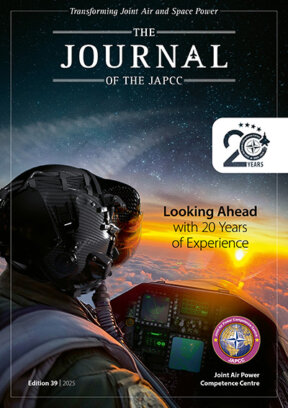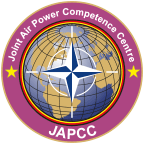Introduction
The rapidly evolving landscape of contemporary warfare has introduced new challenges to Integrated Air and Missile Defence (IAMD) and fundamentally altered the dynamics of defence and deterrence within NATO. Emerging threats, such as Unmanned Aircraft Systems (UAS), commercial drones, and hypersonic weapons exploit existing technical and doctrinal gaps in our aerial defences, posing significant risk to current air defence strategies.
Unmanned platforms, ranging from advanced military-grade UAS to simple commercial-off-the-shelf (COTS) drones repurposed as airborne improvised explosive devices (IEDs), have been used effectively in recent conflicts, including the 2008 Russo-Georgian War and the ongoing war in Ukraine. Adversaries are challenging traditional air defence strategies by exploiting vulnerabilities in sensor coverage, target tracking, command and control (C2), and magazine depth. For instance, Russia’s Shahed-136 UAS has demonstrated the ability to conduct long-range precision strikes while evading detection, especially in the early phases of flight.1 Ukraine’s air defence forces have struggled to detect and track these small UAS (sUAS).
Similarly, Russia has employed Kinzhal hypersonic weapons to target critical infrastructure and civilian assets, forcing Ukrainian forces to reallocate limited defence resources to counter this dangerous threat. This article examines the impact of these emerging threats on IAMD, and explains how adaptation in training and education (T&E) and doctrine can mitigate the risks posed by these new weapons.
Gaps in Current Training and Education for Air Defenders
The rapid integration of UAS and hypersonic weapons into adversaries’ arsenals has exposed training deficiencies among Western air defenders. Traditional training programmes have not sufficiently prepared personnel to identify and classify low, slow, and small (LSS) drones, limiting defenders’ ability to respond effectively.
Additionally, hypersonic weapons, travelling at speeds exceeding Mach 5, present a qualitatively different challenge compared to UAS, LSS, and more traditional supersonic threats. Their high velocity, manoeuvrability, and variable flight paths render existing detection and interception systems less effective. For instance, Hypersonic Glide Vehicles (HGVs) and Hypersonic Cruise Missiles (HCMs) can avoid radar detection by selecting circuitous or off-axis routing which bypasses known tracking sites. Additionally, their variable altitudes and thermal signatures can reduce detection windows and hinder ground and space-based tracking capabilities, thereby reducing response times for defenders.2 The Russian employment of the Kinzhal missile in Ukraine marks a pivotal moment in the operational use of hypersonic technology, demonstrating the ability to strike targets with minimal warning. This capability presents a significant challenge to NATO’s IAMD posture, and further highlights gaps in T&E.
Enhancing NATO’s IAMD Training and Education
Air defenders require specialised training to address emerging threats, focusing on both technical proficiency and cognitive skills.
First, technical proficiency is essential, as personnel must deepen their knowledge in areas such as electronic warfare (EW), cyber defence, and advanced sensor technology. This includes understanding electronic attack and protection measures, mastering the use of cyber defence mechanisms to safeguard critical C2 systems, and becoming proficient with advanced sensors capable of detecting and tracking elusive threats like hypersonic missiles, sophisticated military-grade UAS, and COTS drones. Expanding weapon system-specific knowledge at the tactical level provides defenders with a crucial information advantage.
Secondly, cognitive skills are crucial for air defenders operating under the intense pressures of modern warfare. Hypersonic weapons’ extreme speed and unpredictability significantly compress decision-making timelines, leaving little room for hesitation or error. The same time constraint is true for LSS UAS, which are often detected late. Training programmes must, therefore, enhance decision-making under stress, improve situational awareness, and develop rapid information-processing skills. Techniques such as high-intensity simulations, real-time strategy exercises, and cognitive resilience training can help personnel make swift, accurate decisions in rapidly evolving threat scenarios. Strengthening these cognitive skills ensures air defenders are better prepared for contemporary warfare.
After maximizing the individual capabilities, organizational training enhancements can further strengthen NATO’s air defence posture. Several recommendations should be addressed to improve training against hypersonic and UAS threats:
- Incorporating Realistic Threat Simulations: Advanced simulators for hypersonic weapons and UAS would allow defenders to experience and respond to these threats effectively. Joint exercises with allies can foster best practices, information sharing, and collaborative readiness.
- Enhancing Intelligence Sharing: Strengthening intelligence sharing among western nations is crucial to staying ahead of emerging threats. Platforms such as the Battlefield Information Collection and Exploitation System (BICES) enable seamless information exchange among NATO members, while multinational intelligence cells dedicated to emerging threats ensure that training programmes remain informed by updated intelligence.
- Training to Interoperability: Cross-service and cross-domain integration is essential for a cohesive defence strategy; training air defenders in cyber and space operations enhances their understanding of modern warfare’s interconnected domains. Joint training with international partners strengthens collective readiness, with multinational exercises like NATO’s Joint Warrior and the Technical Interoperability Exercise (TIE) events improve coordination and interoperability, as well as operational cohesion among allies and partners.
Continuous Curriculum Improvements
Training programmes must continually evolve based on operational feedback to ensure air defenders are prepared for emerging threats. The NATO Counter-UAS Working Group plays an important role in these efforts, overseeing the development of courses such as the C-UAS Fundamentals Training (led by the Joint Air Power Competence Centre), C-UAS Operators Training, C-UAS Planners Course, and C-UAS Senior Leadership Seminars. These courses, set to begin in 2025, will serve a valuable role in educating personnel at all levels with an iterative, skills-based training approach. However, at present there are no similar courses dedicated to hypersonic threats. By incorporating both hypersonics and C-UAS into T&E initiatives, NATO will enhance readiness and resilience against these threats.
Doctrinal Changes
Hypersonic and drone threats require improvements to current air defence doctrine due to their unprecedented speed, manoeuvrability, and detection difficulties. Addressing these challenges demands doctrinal improvements to four main areas: threat detection, C2, interoperability, and innovation:
- Improving Threat Detection: Detecting hypersonic threats requires investments in over-the-horizon radar, space-based sensors, and infrared tracking technologies, among other improvements. Refining doctrine in this area can support the national procurement processes of NATO nations and inform changes to the NATO Defence Planning Process (NDPP).
- Integrated, AI-Assisted C2: Compressed timelines associated with hypersonic and drone threats necessitate streamlined decision-making processes. Artificial Intelligence (AI) and machine learning can rapidly process vast amount of data and may enable commanders to make informed decisions in real-time. Pre-defined response protocols may also lead to swift, autonomous countermeasures against threats. However, overcoming ethical and legal obstacles will be a key challenge, and NATO doctrine can lay the foundation for the responsible use of AI in C2 systems.
- Interoperability Across Domains: A cohesive network must integrate air, space, and cyber capabilities. Space-based sensors can detect a hypersonic launch, air-based platforms can track its trajectory, and cyber capabilities can disrupt its guidance systems. Strengthening collaboration in these domains will therefore ensure that different nations’ personnel and systems can work together seamlessly. This collective approach strengthens individual national defences and presents a unified front that can deter potential adversaries, but it must first be codified in NATO doctrine.
- Innovation and Adaptability: Military doctrines must evolve rapidly to anticipate future advancement in tactics and technology, including emerging countermeasures like directed energy weapons and advanced interception platforms. This fast-paced adaptation requires continuous research, development, and adaptive training to keep air defenders ahead of emerging threats.
In essence, countering hypersonic and drone threats demands a forward-thinking approach which uses doctrinal evolution to drive technological advancements in the air defence realm. By enhancing detection capabilities, streamlining command and control, fostering interoperability, and promoting innovation within NATO and partners around the globe, air defence forces can adapt to the complexities of these weapons and strengthen their overall defence posture.
Case Studies: Adaptation by NATO Allies
NATO Allies are implementing new training programmes, integrating advanced technologies, and developing innovative tactics to counter hypersonic and UAS threats:
The German Air Force has recently incorporated hypersonic threat trajectories into its training simulations, enabling personnel to practice detection and interception in realistic scenarios. Regular intelligence briefings update threat assessments, while collaborative workshops with defence agencies drive innovation in counter-hypersonic strategies. Limited access to detailed threat data remains a challenge, highlighting the need for improved intelligence-sharing mechanisms within NATO frameworks, such as the BICES network.3
The Netherlands’ Defence Ground-based Air Defence Command (DGLC) addresses emerging IAMD threats through advanced courses such as the Patriot Advanced Capability (PAC) course and Weapon Instructor Courses (WIC). They partner with scientists and knowledge institutes to stay ahead of technological developments, ensuring that lessons learned from recent conflicts, including Ukraine, are integrated into their national training programmes. The Dutch Army also employs passive defence measures such as mobility and decoys to complicate adversary targeting and ensure survivability.4
The Russia-Ukraine war has demonstrated numerous practical and innovative tactics, including EW to jam enemy UAS, ‘SAMbush’ tactics against glide bombs and low-flying munitions, and rapid tactics, techniques, and procedures (TTP) adaptation to counter new threats. Ukraine’s ability to adjust TTP in real time underscores the importance of agility and a robust feedback loop across frontline operators and command structures.5
Australia has also emphasized emerging technologies in training and operations. Their forces highlight the importance of decentralized command structures, allowing lower echelons to make rapid decisions in dynamic threat environments. Additionally, interagency cooperation strengthens readiness across military branches and civilian agencies.6
These adaptations highlight the importance of innovation, flexibility, and continuous learning in countering hypersonic and UAS threats. By incorporating real-world insights and unconventional tactics into training and operations, NATO Allies can refine their IAMD capabilities to address the complexities of modern warfare.
Conclusion
Adapting training, education, and doctrine is imperative for defending against hypersonic and UAS threats. Adversaries identify and exploit vulnerabilities in technology, training, and doctrine making proactive adaptation essential. To stay ahead, air defenders must evolve their TTP in an iterative manner, making their systems and tactics more resilient, unpredictable, and effective against emerging threats. This requires a holistic approach that combines doctrinal changes, rigorous training, realistic exercises, and information sharing across NATO members.
Incorporating advanced technologies such as AI for real-time threat assessment, machine learning for predictive analytics, and automated response systems enables defenders to address threats faster and more accurately. This aids human operators where they are not available or lack the necessary reaction time future conflicts demand. Adaptability in tactics is equally important, allowing air defenders to adjust to enemy methods in real-time – whether this means employing electronic warfare against drones, using dispersed radar to counteract hypersonics, or coordinating cyber assets to disrupt adversary command networks. By fostering a culture of innovation and adaptability within the IAMD community, NATO can close technological and doctrinal gaps and ensure the security of NATO airspace.











